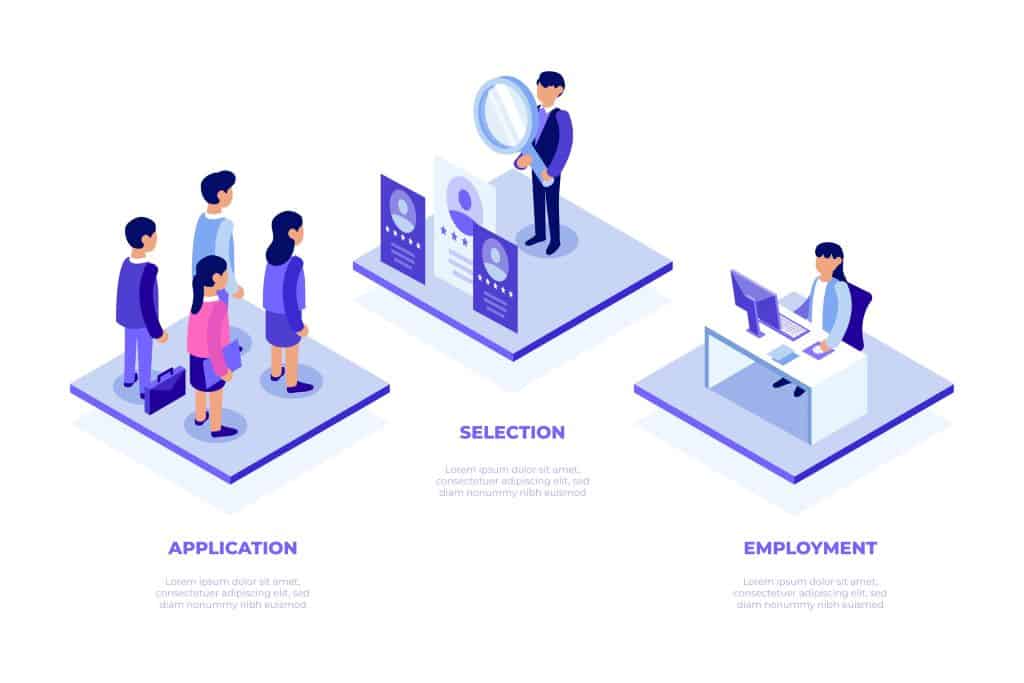A resume is your identity card in the battle of job searching. This is the first thing that your recruiter will look at before even having a one-on-one interaction with you. However, on average, a recruiter looks at these resumes for only six to seven seconds, so having known this fact, the first goal of any job seeker becomes to make sure that his resume stands out and the recruiter spends more time reading his details. But, many people find it tough to align their resume to this goal and thus fail to make an impactful first impression. This article will provide you with some important and useful resume-building tips that can help you improve your resume and can increase your chance of getting an interview call.
Before getting ahead with the resume-building tips, let’s first understand the difference between a resume and a CV. As these two are equally important terms but often confuse people.
Difference Between Resume And CV
CV is an abbreviation for Curriculum Vitae and primarily means the course of your life. It is documentation that covers a comprehensive step-by-step description of your career journey including every personal and professional detail. It includes in-depth details about your personal life, qualifications, professional career, and every achievement. Moreover, it is generally submitted for credential-based purposes like academics, scientific research, and medical fields.
However, a resume is short, cut to a point and brief documentation having a summary of your experience and skills, created specifically for applying to a specific job. In around 99% of the cases, resumes are created for a maximum of one page and contain all the briefing about your professional career, or in certain cases, it can be extended to two pages. These are competency-based and are tailored according to the requirements of the job that you are applying to. Its sole purpose is to showcase the candidate’s skills, notable achievements, and work experience relevant to the role.
Top 12 Resume-Building Tips You Should Keep In Mind While Drafting The Resume
There are a few commonly followed resume styles that are mostly used for building a resume. However, your resume reflects your uniqueness whether it be education, experience, or skill sets to the employer, so it must be crafted to show the best version of you. Here are a few key resume-building tips that will help you design and organize your resume such that it enhances your relevant skills tailored to the job you are applying to and increases your chances of getting selected. Below are 10 tips to help you draft a great resume.
- Keep it skimmable
The readability and scannability of the resume play a very important role in deciding whether the hiring manager will read it or not. No recruiter has the time to read out every resume and they don’t even spend a lot of time on each of them. However, keeping it short and to the point and designing it in a way that appeals to the eyes can increase your chances to get noticed. Thus the first golden rule of resume-building is to add the relevant and necessary details only, Instead of adding everything to it, highlight the part of your career that can summarize your working experience. For example, a year-long job can teach you a lot of skills, but putting everything is not a good option, so select and add those skills only that go along with the job that you are applying for now.
You can also exclude your previous job experiences if you have more than say 15-20 years of experience. Many experts recommend including the jobs from the last 10-12 years only. Including too much can also make it boring for the recruiter to go through. So keep it simple, focused, clear, and concise. - Optimize your resume with keywords from the Job Description
The first thing to do while preparing to write a resume is to scan the job description carefully and make a list of the words that you feel can be added to the resume to make it a perfect fit. You can use these words as bullet points to customize the resume and match its relevance to the job. You can also try to customize it with a perfect mix of various types of keywords including soft skills, hard skills, industry buzzwords, certifications, and more. These keywords will help a recruiter scan for what he is looking for in the ideal candidate. These also help you get shortlisted in the applicant tracking systems that recruiters use for initial screening.
For example, If you are planning to apply for a job as a Coder or Programmer, then consider picking keywords that the recruiter has used in the job description for the description of experience, qualifications, skills, and languages known. These can be the framework, Java, Python, test-driven, gather, analyze, decoding, and many more related to the role. - Place your best stuff on the high points
It is always considered a wise decision to put your best accomplishments, achievements, and experiences above the fold on the resume. This means keeping the best stuff in the first half of the resume. Any recruiter will only spend the first 6 minutes scanning the document and deciding whether he wants to continue reading your expertise or not so it is a most common practice to put the key achievements and skills at the top to make an impactful first impression. It will allow you to let the recruiter know exactly what you wanted him to know and scan and get you noticed. In the other words, this will act as a hook to catch the recruiter’s eye to the most relevant information that he needs to know about you. Try including the work experience, achievements, education, and skills that are most relevant to the job posting. - Keep the events in reverse chronological order
A resume should be well organized and arranged in a proper format. There are many ways the information in the resume can be arranged like the functional resume, combination resume, or the old and best one the chronological resume. A chronological resume is the resume format that presents the relevant professional experiences and expertise in an orderly way. It is also known as ‘reverse chronological’ and lists the entities from the most recent ones to the least recent. This format is best suited for those having a consistent work history and who have increased job levels at every switch. In case of significant gaps in the career or frequent industry switches, a functional or combination resume format is the best choice. - Use numbers and metrics to demonstrate results, and achievements
This is an awesome resume-building tip that can help you demonstrate your exception from others and provide you with an extra edge in resume screening. While showcasing your achievements in the resume, try to quantify the accomplishments, this will allow the recruiter to picture the level of your work, expertise, and responsibilities that you have mastered. Try including as many facts, numbers, and figures as you can put in the bullet points like the number of the team members you had led, the percentage of the tasks you handled while achieving the goal, etc. for example, executed more than 80 cold calls daily with the conversion rate of 8%.
These numbers and metrics also give a measurable proven value to your achievements and make your resume presentable and easily scannable while proving your authenticity. - Avoid commonly used vague terms and detailed personal information on it
The most common mistake that everyone makes while drafting a resume is using words that are very common and could be found in any resume. These words include some common terms like detail-oriented, hard worker, and team player. These are the qualities that any recruiter would wish to have in his employee, so paying more attention to such vague words won’t help you much. In order to make it stand out, you need to replace these words with some better and more powerful vocabulary.
The other thing that you need to consider is that no recruiter wants to know your family history in detail. So it is better to avoid putting detailed personal information on it. Just name, contact information, location, and email address are more than sufficient. - Showcase your work
Your resume is your chance to speak up to your recruiter. It is your opportunity to make him know how you stand out from others without being too wordy. The best practice for this is to include some of the visuals of your work. Your work can speak on your behalf. You can include links to your live projects or your personal website or some of the achievements that can be seen online. You can also include your social media profiles like LinkedIn, Github, and others that are relevant to the job listing. - Avoid adding short-term roles
Adding short-term or non-temporary jobs to your resume can raise questions about your work authenticity. Avoid eliminating jobs from your resume that you have done for only a matter of months. However, if you don’t have much experience and do not want to leave the little experiences of your work history that you have, try to list the jobs with only years(2020-2021) and not with start and end dates. - Use Professional fonts and active languages
Avoid using informal or very complicated fonts in your resume, it won’t grab your recruiter’s attention but would make it look bulky and very unprofessional. This will also reduce its chances of getting scanned through automation screening systems. Try using basic yet professional and modern fonts like Times New Roman, Calibri, Arial, or Century Gothic. Use the correct font size for the heading and the body text, neither too small nor too big something between 10 and 12 and leave a good amount of white space on the page which makes the sections look a bit clear. Use an active voice for describing the details and avoid speaking in the third person. - Proofread and Edit it thoroughly
Like every other piece of content, the resume should also be proofread and edited thoroughly. Any spelling or typo mistakes can ruin your impression. Always make sure your resume is free from any grammatical errors or typos. Spell check it twice or thrice as needed to make it error-free. - Name it smartly
It is very common practice for everyone to name the document according to their convenience and preference, however, in the case of resumes, it is considered good practice to name them smartly including your full name along with resume as a suffix.
A recruiter can get hundreds of resumes every day, so naming it wisely can also ease their work of shortlisting the desired one plus a proper name can assure that he opens it without displacing or losing it. - Save it as a PDF format
Another master hack for you is to always save and share your resume in PDF formats rather than a document file. This will make sure that the formatting won’t get messed up at the other end when the hiring manager opens it on his computer.
Conclusion
This blog aims to provide you with the best resume-building tips to make sure your resume is always up to the point. These resume-building tips can help you create presentable copies of your resume for your next job. For more such career updates and hiring and staffing, tips visit https://bridgentech.com/
FAQs
What is the chief difference between a CV and a resume?
A CV is a detailed version of your career journey while a resume highlights your work experience concisely in one or a maximum of two pages.
What are the main resume-building tips?
There are many resume-building tips that you should follow to create a professional resume like using keywords, formatting, etc. This blog will help you with many resume-building tips that you can consider while drafting your resume.








